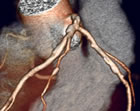
|
Angioplasty.Org recently sat down with Dr Hecht to discuss a range of topics, from reimbursement issues to how he feels CTA will change the diagnostic paradigm for patients with suspected coronary artery disease. Q: Last year Medicare announced plans to stop reimbursement almost entirely for computed tomographic angiography (CTA) and then earlier this month reversed
itself.
The second point is they said that there was no evidence that CTA improved patient outcomes. This was a totally hypocritical, double-standard stance on their part because that kind of evidence has never been provided for any cardiology technology. It has never been provided for echocardiography, for nuclear stress testing, for cardiac catheterization, for electrocardiography. The kind of trials that the critics have been asking for, involving randomized controlled trials, in which one group of patients gets the test and another group of patients doesn't get the test, in order to demonstrate that the use of the test improves outcomes -- that has never, ever been applied to any technology that we use. They were just using that as an excuse in the name of academic righteousness, which is to demand a randomized controlled trial for everything. They were using that to delay implementation of this technology which is the best thing that has happened to cardiology in the past decade. Q: Why do you consider CTA to be so revolutionary?
The second issue is that when you do a CTA, in general in patients who do not have established heart disease, you also do a calcium score, obtained from a non-contrast CTA, which is the best prognostic tool for cardiac outcome that we have available to us. And that's been around for approximately 15 years, and unequivocally is far superior to anything, particularly the Framingham risk score, for your evaluation of the patient's cardiac risk. There's an enormous amount of data from tens of thousands of patients, and most recently the MESA study results are beginning to emerge, which show exactly the same thing: that a coronary calcium score is far and away independently the most powerful prognosticator of cardiac outcome in the asymptomatic population. Had the Medicare ruling stood, it would have marked the death knell of coronary calcium. Because nobody pays for coronary calcium scoring right now except, I think, California. And coronary calcium scoring would have probably very likely been trashed along with CTA. And at this point, the absence of reimbursement for coronary calcium screening to me is unconscionable. We have a tool now that can identify the pool of patients out of which 95% of the myocardial infarctions will emerge, and we're not using it. Q: Coronary calcium scoring is a major part of the recent SHAPE guidelines that you were one of the authors of.
The nay-sayers still harp on, “There is no data showing us that patients who have a coronary calcium score do better than those who don't have a coronary calcium score”, and the response to that is exactly the same as we talked about with CTA. There's no data that the Framingham risk score has any effect on outcomes! And it's very clear that CTA is better than the Framingham risk score, so why not use the test that's better? It's incredibly straightforward. And I think it's a lapse on the part of the medical establishment to not have adopted it by this time. Every year there are 500,000 MIs [heart attacks] as the first symptom of heart disease, 150,000 of which are fatal. Coronary calcium can identify the pool of high risk patients out of which 95% will emerge. Just by putting those patients on a statin, you've reduced events by 30%. Add a drug to improve HDL and triglycerides, you get much more of a decrease in events. Appropriate cost-effective analysis shows that it is the most cost-effective method, because the cost of a coronary calcium score will become that of a mammogram. A big objection has been, “Well, it’s expensive.” Well, mammography was expensive when it first came out, and now it's less than $100, and it will be the same with coronary calcium. People have to look upon heart disease with the same respect and attention that we do with breast cancer. Every year, every woman over 45 gets a mammogram for a disease that kills about 45,000 women every year. Heart disease kills 500,000 women every year, and they are simply not screened for it. Why not? And of course the argument applies to men as well. And in the future, once coronary calcium does become like mammography, people will say “Look at all the lives we wasted by not doing it earlier”. Q: So how can this change occur?
Q: Other criticism leveled at CTA is the amount of radiation exposure. For example, there was a recent study published in the New England Journal of Medicine that was done at Columbia. Q: What are these new methods to reduce radiation exposure?
Q: Another concern expressed by Medicare and critics of CTA is that it will lead to a slew of unnecessary tests.
On a nationwide basis, if you look at the ACC National Cardiac Data Registry (NCDR), 37% of the caths done in stable patients show no significant disease, and these tests could have been avoided had there been a better triage to get into the cath lab. The problem is that the stress testing has been the gatekeeper, and there are many false positives with stress testing. The experience of anybody who's been involved with CTA is that the number of normal caths in their institution plummets. So from the insurance company and the national health economic perspective, you will have a dramatic decrease in costs that were allocated for unnecessary reasons: there was no disease found, in addition to the associated morbidity and mortality, however small, that's associated with an invasive angiogram. Q: The risk of stroke or death during an invasive cath is very small, but the rate of bleeding complications at the access site, nerve trauma and so on is 3-4%, some say more.
Q: Won’t this development negatively
affect interventional cardiologists? And we all know that intravascular ultrasound (IVUS) tells a very different story than the luminography that we get in the cath lab. You can have diffusely narrow segments which appear totally normal on an angiogram because there's no focal narrowing: the whole segment is narrowed. You see that very easily on intravascular ultrasound. CTA also has those capabilities, so it will more accurately uncover those patients who need to have a procedure. Q: Would the use of CTA impact the use of IVUS.
For example if you see an atypical type of lesion on the CTA, would
you then use IVUS in the cath lab to guide the balloon or stent for
this patient? In the intermediate range, the 50 to 75% stenosis and those that meet the IVUS criteria that we apply to CTA, which is less than 4mm2 for the proximal vessels, and less than 6mm2 for the left main, they are then candidates for either a stress test to determine the functional significance of those or, if one is not happy with stress testing in the particular situation, they can go straight to the cath lab, and if the angiogram confirms the severity of the disease that is shown on the CTA, then they can have a procedure, assuming that the clinical situation is appropriate. But if there is a disconnect, if the disease is angiographically inapparent, but was present on the CTA, then either IVUS or FFR is mandated to use as the gold standard for what is really going on in that vessel. So, it will be a change in the paradigm.
|



